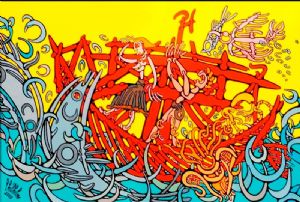| |

|

|
M87 - SHIP-TO SKELETON raging sea - 2008.
Painting Acrylic
Size: 97 x 146 cm or 38 x 57,4 inches
9000 USD
Description:
MINOAN / (Text translated by Google) / It is not surprising that the Minoan ship has been for centuries a symbol of Cretan major. Thucydides had already mentioned a thalassocracy Minoan actually sea pirates, and a total absence of fortifications, ports and cities near the sea several types of vessels have been identified include the most important : ship flies - Cycladic type vessel - increasing curve symmetrical - wing ship vessel - drift symmetrical angular - rafts. Our boat belongs to all the fin-type drift to the ship curve symmetrical growing! Naturally, the skeletal representation is not only symbolic but also linked to the minimal size of the original seals! Moreover, as none were ever identical to another, sometimes it is difficult to recognize even a ship, so the performance has been customized and stylized *! But the stakes planted vertically on the deck, with a network of cross between them represent a sail stretched between two poles. From there, it is easy to read the rest! On many seals, we often find a large number of growing horns laid up on top and between the pious in this case, the growing problem is increasing, as many waves in a stormy sea ... Have you noticed the monogram the artist's stylized top of main mast? When the two fish, octopus, sea bird in flight with fish in its beak, not forgetting the dog on the boat, they are powerful symbols of Minoan iconography. We will identify more in the following tables ... Finish too quickly by the sailors, the first woman with her skirt typical Cretan and the man often depicted naked with a single, double or triple belt.
* Custom seals: as the locks were not yet available, each family had its Cretan seal, which allowed to identify the owner, thus leaving his home on Crete he took a cord wrapped on both sides of the door and a hook on the wall, then crushed a piece of soft clay on the knot of the cord and affixed his seal to the most often with a ring. He did the same when he sent a parcel which he tied up and pressed his ring on the clay deposited on the knot! Each Cretan saw the imprint knew who it belonged! No wonder we have found many different seals all representatives sometimes threatening, like scorpions or poisonous spiders, when you know you were superstitious in those days! Depending on the periods and regions, the seal was also used to authenticate certain documents such as accounting or administrative contracts or as amulets, which is still the case today in many parts of the world!
|
|

|
|